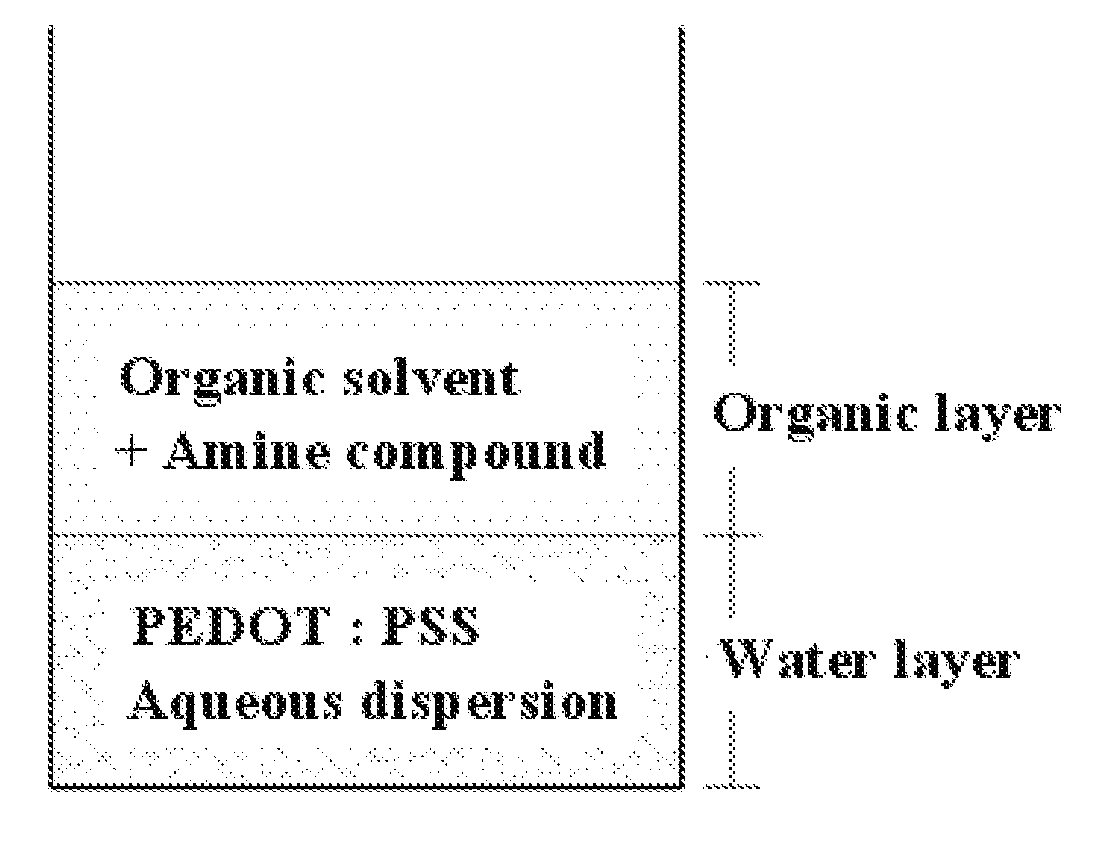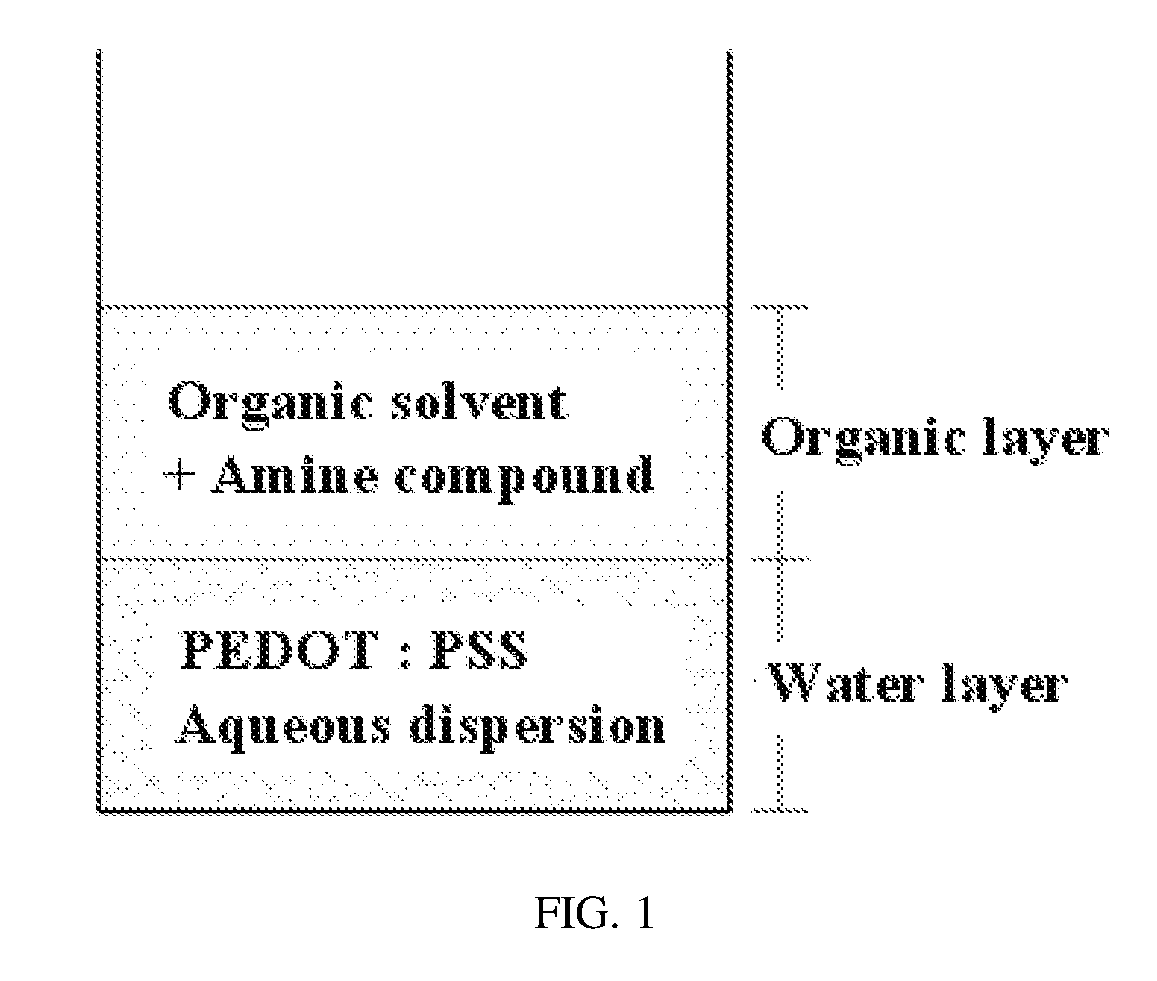Conductive polymeric ink composition
a polymer and ink technology, applied in the field of ink compositions, can solve the problems of reducing conductivity, shortened lifetime of devices, corroded systems, etc., and achieve the effect of reducing the haze caused by scattering of light on the substrate, preserving the dispersion of pss, and reducing the lifetime of devices or systems
- Summary
- Abstract
- Description
- Claims
- Application Information
AI Technical Summary
Benefits of technology
Problems solved by technology
Method used
Image
Examples
example 1
[0053]4 g of PH-1000 (made by Heraeus) as a PEDOT:PSS aqueous dispersion was added with 4 g of diethyl ether and 0.05 g of triethylamine Mixing was performed for 2 hr so that a water layer and an organic layer were combined, after which the organic layer was removed. Also, 4 g of diethyl ether was further added to wash the water layer, after which the organic layer was decanted. Washing the water layer was repeated 2˜3 times, thus obtaining a neutralized PEDOT:PSS aqueous dispersion. The amount of the amine compound triethylamine contained in 4.2 g of the neutralized PEDOT:PSS aqueous dispersion thus obtained was measured to be 0.017 g. 4.2 g of the neutralized PEDOT:PSS aqueous dispersion was added with 0.18 g of DMSO, 3.6 g of DI water, 2.16 g of propylene glycol, 1.44 g of butyl carbitol, and 0.006 g of a surfactant F-555 (made by DIC) and then stirred, yielding a PEDOT:PSS ink composition.
example 2
[0054]A PEDOT:PSS ink composition was prepared in the same manner as in Example 1, with the exception that 2,4,6-trimethylpyridine was used as the amine compound, instead of triethylamine. The amount of the amine compound 2,4,6-trimethylpyridine contained in 4.2 g of the neutralized PEDOT:PSS aqueous dispersion thus obtained was measured to be 0.016 g.
preparation example
[0059]Each of the ink compositions of Examples 1 and 2 and Comparative Examples 1 to 3 was subjected to spin coating (500 rpm, 9 sec), and then dried on a hot plate at 120° C. / 30 min, thus forming individual PEDOT:PSS thin films.
[0060]
[0061]Measurement of pH
[0062]The ink compositions of Examples 1 and 2 and Comparative Examples 1 to 3 were measured for pH using a Jenway Model 430 portable pH / conductivity meter.
[0063]
[0064]The PEDOT:PSS thin films formed in Preparation Example were measured for sheet resistance using a 4-point-probe. The results are shown in Table 2 below.
[0065]Also, transmittance and haze of the thin films were measured.
TABLE 2sheetTransmittanceresistanceAmine compoundpH(%)Haze(Ω / )Ex. 1Triethylamine7.589.160.35804Ex. 22,4,6-trimethylpyridine5.788.450.55335C. Ex. 1Ammonia water————C. Ex. 2X2.488.430.18312C. Ex. 33,5-diethylpyridine6.189.854.434250
[0066]As is apparent from Table 2, the ink compositions of Examples 1 and 2 according to the present invention were forme...
PUM
| Property | Measurement | Unit |
|---|---|---|
| weight | aaaaa | aaaaa |
| concentration | aaaaa | aaaaa |
| total weight | aaaaa | aaaaa |
Abstract
Description
Claims
Application Information
 Login to View More
Login to View More - R&D
- Intellectual Property
- Life Sciences
- Materials
- Tech Scout
- Unparalleled Data Quality
- Higher Quality Content
- 60% Fewer Hallucinations
Browse by: Latest US Patents, China's latest patents, Technical Efficacy Thesaurus, Application Domain, Technology Topic, Popular Technical Reports.
© 2025 PatSnap. All rights reserved.Legal|Privacy policy|Modern Slavery Act Transparency Statement|Sitemap|About US| Contact US: help@patsnap.com


